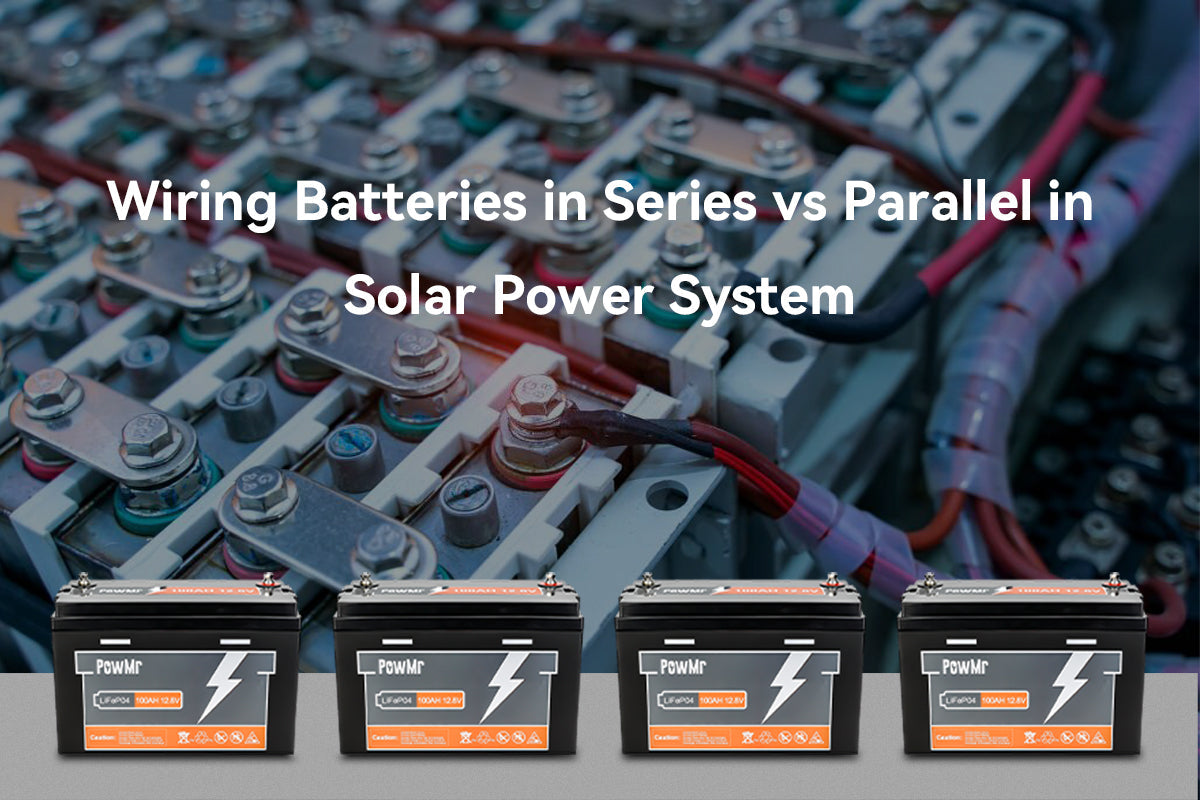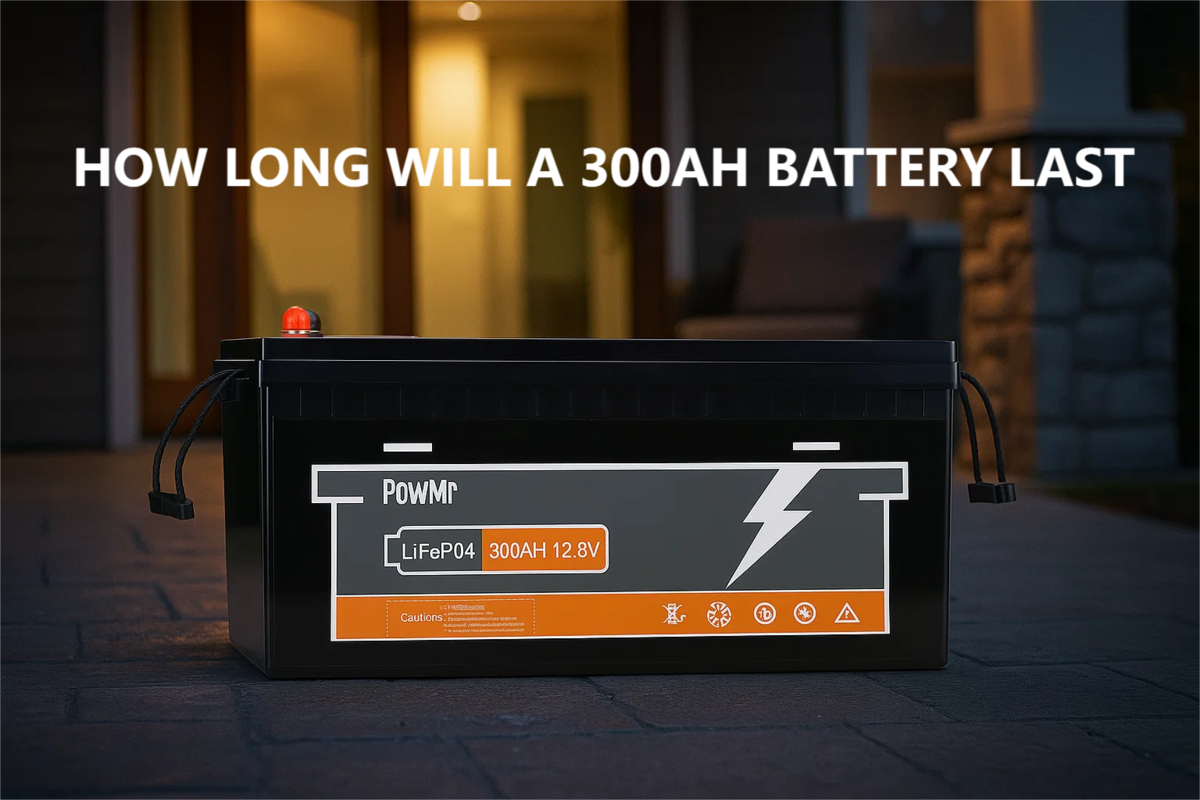ในโลกของระบบพลังงานแสงอาทิตย์ การเชื่อมต่อแบตเตอรี่เป็นปัจจัยสำคัญที่มีผลต่อประสิทธิภาพโดยรวม การตัดสินใจเชื่อมต่อแบตเตอรี่แบบอนุกรมหรือขนาน หรือผสมผสานทั้งสองอย่าง มีผลอย่างมากต่อประสิทธิภาพและอายุการใช้งานของระบบ คู่มือฉบับสมบูรณ์นี้จะสำรวจรายละเอียดของตัวเลือกเหล่านี้
- แบตเตอรี่แบบอนุกรมกับแบบขนาน - แตกต่างกันอย่างไร?
- การเดินสายแบตเตอรี่แบบอนุกรม
- จำนวนแบตเตอรี่ที่เชื่อมต่อแบบอนุกรม
- ข้อดีของการเดินสายแบตเตอรี่แบบอนุกรม
- ข้อเสียของการเดินสายแบตเตอรี่แบบอนุกรม
- การเดินสายแบตเตอรี่แบบขนาน
- แบตเตอรี่แบบอนุกรมกับขนาน: แบบไหนเหมาะกับคุณ?
- คุณสามารถเดินสายแบตเตอรี่แบบอนุกรมและขนานได้หรือไม่?
- เคล็ดลับการเชื่อมต่อแบตเตอรี่โซลาร์
แบตเตอรี่แบบอนุกรมกับแบบขนาน - แตกต่างกันอย่างไร?
การเลือกการตั้งค่าแบตเตอรี่ที่เหมาะสมขึ้นอยู่กับความต้องการของอุปกรณ์และความต้องการพลังงานของคุณ นี่คือภาพรวมอย่างรวดเร็วของวิธีการทำงานของแต่ละประเภทการเชื่อมต่อ:
- การเชื่อมต่อแบบอนุกรม = แรงดันไฟฟ้ารวมกัน, ความจุเท่าเดิม
- การเชื่อมต่อแบบขนาน = ความจุรวมกัน, แรงดันไฟฟ้าเท่าเดิม
| คุณสมบัติ | การเชื่อมต่อแบบอนุกรม | การเชื่อมต่อแบบขนาน |
|---|---|---|
| แรงดันไฟฟ้า (V) | ผลรวมของแรงดันไฟฟ้าของแบตเตอรี่ทั้งหมด | คงที่เท่ากับแบตเตอรี่ก้อนเดียว |
| ความจุ (Ah) | คงที่เท่ากับแบตเตอรี่ก้อนเดียว | ผลรวมของความจุแบตเตอรี่ทั้งหมด |
| กระแสสูงสุด (A) | คงที่ (จำกัดโดยแบตเตอรี่ที่อ่อนแอที่สุด) | รวมกัน (ผลรวมของกระแสสูงสุดของแบตเตอรี่ทั้งหมด) |
| การกระจายโหลด | กระแสของระบบเต็มที่ไหลผ่านแบตเตอรี่แต่ละก้อน | กระแสของระบบจะแบ่งไปยังแบตเตอรี่แต่ละก้อน |

การเดินสายแบตเตอรี่แบบอนุกรม
เชื่อมต่อ ขั้วลบ ของแบตเตอรี่ก้อนแรก กับขั้วบวก ของแบตเตอรี่ก้อนที่สอง ทำซ้ำรูปแบบ "daisy chain" นี้กับแบตเตอรี่ทุกก้อน ผลลัพธ์สุดท้ายของชุดแบตเตอรี่ของคุณจะเป็นขั้วบวกของแบตเตอรี่ก้อนแรกและขั้วลบของแบตเตอรี่ก้อนสุดท้าย
บทความที่เกี่ยวข้อง:
จำนวนแบตเตอรี่ที่เชื่อมต่อแบบอนุกรม
การเชื่อมต่อแบตเตอรี่แบบอนุกรมจะเพิ่มแรงดันของระบบ ดังนั้นจำนวนการเชื่อมต่อแบบอนุกรมขึ้นอยู่กับ แรงดันที่ระบบของคุณต้องการ เช่น 12V, 24V หรือ 48V
- ระบบ 12V เป็นการตั้งค่าพลังงานแสงอาทิตย์ที่พื้นฐานที่สุด โดยต้องใช้แบตเตอรี่ 12V เพียงก้อนเดียว เหมาะสำหรับรถบ้าน เรือ อุปกรณ์ตั้งแคมป์ และไฟส่องสว่างกำลังต่ำ ให้กำลังไฟที่พอเหมาะสำหรับการใช้งานเคลื่อนที่
- ระบบ 24V ต้องเชื่อมต่อแบตเตอรี่ 12V สองก้อนแบบอนุกรมเพื่อให้ได้แรงดันไฟฟ้ารวม 24V พบได้ทั่วไปในรถบ้านขนาดกลาง บ้านออฟกริดขนาดเล็ก และสถานีโทรคมนาคม ซึ่งช่วยลดกระแสไฟลงครึ่งหนึ่งเมื่อเทียบกับ 12V ลดการสูญเสียและเพิ่มประสิทธิภาพ
- ระบบ 48V เป็นการตั้งค่าที่พบบ่อยที่สุดสำหรับการจัดเก็บพลังงานแสงอาทิตย์ในที่อยู่อาศัย โดยต้องใช้แบตเตอรี่ 12V สี่ก้อนเชื่อมต่อแบบอนุกรม ใช้กันอย่างแพร่หลายในที่อยู่อาศัยและการติดตั้งขนาดใหญ่

นอกจากนี้ การรับรองความปลอดภัยและข้อกำหนดประกันภัยอาจกำหนดข้อจำกัดในการเชื่อมต่อแบบอนุกรม เช่น แบตเตอรี่ PowMr 12V 100Ah อนุญาตให้เชื่อมต่อแบบอนุกรมได้สูงสุด 4 ยูนิต
โปรด ปฏิบัติตามค่าสูงสุดที่ผู้ผลิตกำหนด โดยคำนึงถึงข้อจำกัดของระบบจัดการแบตเตอรี่ มาตรฐานความปลอดภัย ข้อกำหนดการรับรอง และข้อผูกพันด้านการรับประกัน
ข้อดีของการเดินสายแบตเตอรี่แบบอนุกรม
แรงดันไฟฟ้าที่เพิ่มขึ้น: โดยการเชื่อมต่อแบตเตอรี่ LiFePO4 12V 100Ah สี่ก้อนแบบอนุกรม จะได้ระบบแรงดันไฟฟ้า 48V ที่แข็งแกร่งโดยไม่สูญเสียความจุรวม การเชื่อมต่อนี้ยังคงความจุ 100Ah แสดงให้เห็นถึงความยืดหยุ่นของการเดินสายแบบอนุกรม
กระแสไฟฟ้าต่ำและสายไฟที่บางลง: สำหรับพลังงานเท่ากัน (Power = Voltage × Current) แรงดันไฟฟ้าที่สูงขึ้นจะทำให้กระแสไฟฟ้าต่ำลง ซึ่งช่วยให้คุณใช้สายไฟที่เล็กลงและราคาถูกลง และลดการสูญเสียพลังงานในสายไฟยาว
ประสิทธิภาพที่เพิ่มขึ้นในการส่งกำลังไฟฟ้า: การเพิ่มแรงดันไฟฟ้าของระบบจากการเดินสายแบบอนุกรมทำให้กระแสไฟฟ้าของระบบลดลง ซึ่งช่วยให้ใช้สายไฟที่บางลง ส่งผลให้ประสิทธิภาพในการส่งกำลังไฟฟ้าดีขึ้นและลดการตกของแรงดันไฟฟ้าภายในระบบ
ข้อเสียของการเดินสายแบตเตอรี่แบบอนุกรม
จำกัดโดยแบตเตอรี่ที่อ่อนแอที่สุด: ในการเชื่อมต่อแบบอนุกรม ประสิทธิภาพโดยรวมถูกจำกัดโดยแบตเตอรี่ที่อ่อนแอที่สุด ความแตกต่างใน State of Charge ระหว่างแบตเตอรี่สามารถทำลายแบตเตอรี่ทั้งหมด ดังนั้นการปรับสมดุลอย่างมีประสิทธิภาพด้วย BMS คุณภาพสูงจึงมีความสำคัญเพื่อปกป้องชุดแบตเตอรี่และรับประกันความน่าเชื่อถือในระยะยาว
ความซ้ำซ้อนลดลง: หากแบตเตอรี่ก้อนใดก้อนหนึ่งในชุดอนุกรมเสียหายหรือความจุลดลงอย่างมาก จะส่งผลกระทบต่อแบตเตอรี่ทั้งหมด และส่งผลต่อประสิทธิภาพโดยรวมของอุปกรณ์ที่เชื่อมต่อหรือระบบทั้งหมด
ข้อจำกัดของการใช้งานแรงดันไฟฟ้าสูง: การทำเช่นนี้ต้องการให้แอปพลิเคชันทั้งหมดของคุณทำงานที่แรงดันไฟฟ้าสูงขึ้น เช่น เมื่อคุณเชื่อมต่อแบตเตอรี่ 12V สองก้อนแบบอนุกรม แรงดันไฟฟ้าที่ได้จะเป็น 24V หากไม่ใช้ตัวแปลง คุณจะไม่สามารถจ่ายไฟให้กับอุปกรณ์ 12V ใดๆ ในการตั้งค่านี้ได้
การเดินสายแบตเตอรี่แบบขนาน
เมื่อเชื่อมต่อแบตเตอรี่แบบขนาน ให้เชื่อมต่อขั้วบวกเข้าด้วยกันและเชื่อมต่อขั้วลบเข้าด้วยกัน แม้ว่าการเดินสายจะค่อนข้างง่ายสำหรับจำนวนแบตเตอรี่เล็กน้อย แต่การเชื่อมต่อแบบขนานขนาดใหญ่ต้องการการออกแบบวงจรที่ดีเพื่อให้กระแสไฟฟ้ากระจายอย่างสมดุล
แนะนำให้ใช้ การเดินสายแบบทแยงมุมหรือ battery busbarsเพื่อป้องกันความร้อนสูงเกินไปหรืออายุการใช้งานที่ลดลงจากการกระจายกระแสที่ไม่สม่ำเสมอ สำหรับแผนผังการเดินสายและแนวทางปฏิบัติที่ดีที่สุด โปรดดูคู่มือมืออาชีพของเรา
บทความที่เกี่ยวข้อง:
จำนวนแบตเตอรี่แบบขนาน
จำนวนแบตเตอรี่ที่สามารถเชื่อมต่อแบบขนานขึ้นอยู่กับหลายปัจจัย รวมถึงความจุของ Battery Management System (BMS) สเปคสายไฟ และคำแนะนำเฉพาะของผู้ผลิต
ภายในขอบเขตที่ปลอดภัย จำนวนแบตเตอรี่สามารถกำหนดได้ตาม ระยะเวลาการจ่ายไฟ ที่ระบบต้องการ ระบบแบตเตอรี่ส่วนใหญ่รองรับการเชื่อมต่อแบตเตอรี่ 2-4 ก้อนแบบขนานสำหรับการใช้งานในบ้าน
พิจารณารถบ้านออฟกริดที่ใช้พลังงานวันละ 10kWh:
- แบตเตอรี่ 48V, 100Ah (5kWh) ต้องใช้แบตเตอรี่ขนานสองชุดสำหรับการสำรองไฟสองวัน
- ต้องใช้แบตเตอรี่ขนานสี่ชุดสำหรับการสำรองไฟสี่วัน

ความสามารถในการขยายของการเชื่อมต่อแบตเตอรี่แบบขนานช่วยให้ง่ายต่อการวางแผนความจุ เหมาะอย่างยิ่งสำหรับการใช้งานที่ต้องการการทำงานอิสระเป็นเวลานาน เช่น ระบบออฟกริด การสำรองไฟในช่วงไฟดับนาน หรือการเก็บพลังงานตามฤดูกาล
ข้อดีของการเดินสายแบตเตอรี่แบบขนาน
ความจุและระยะเวลาการทำงานที่เพิ่มขึ้น: การเชื่อมต่อแบตเตอรี่แบบขนานช่วยเพิ่มความจุรวมในขณะที่รักษาแรงดันไฟฟ้าของระบบแบตเตอรี่ให้คงที่ ทำให้ระยะเวลาการจ่ายไฟของระบบยาวนานขึ้น
ตัวอย่างเช่น หากคุณมี แบตเตอรี่ 24V 100Ah สองก้อน เชื่อมต่อแบบขนาน ความจุรวมจะเป็น 200Ah แรงดันไฟฟ้ายังคงเท่าเดิม แต่ระยะเวลาการทำงานของแบตเตอรี่จะเพิ่มเป็นสองเท่า
โพสต์ที่เกี่ยวข้อง:
แบตเตอรี่ 200ah จะใช้งานได้นานแค่ไหน – อธิบายแอมป์ชั่วโมง
2 ขั้นตอนในการคำนวณว่าแบตเตอรี่ 12v จะใช้งานได้นานแค่ไหนกับอินเวอร์เตอร์
ความซ้ำซ้อนของระบบ: หากแบตเตอรี่ก้อนใดก้อนหนึ่งในระบบขนานมีประสิทธิภาพลดลงหรือเสียหาย แบตเตอรี่ที่เหลือยังสามารถจ่ายไฟให้กับระบบได้ ซึ่งช่วยเพิ่มความทนทานต่อความผิดพลาดเมื่อเทียบกับการจัดเรียงแบบอนุกรม แม้ว่าความจุโดยรวมจะลดลง
ความเข้ากันได้ของแรงดันไฟฟ้า: การเดินสายแบบขนานรักษาแรงดันไฟฟ้าเท่ากับแบตเตอรี่แต่ละก้อน ทำให้ไม่จำเป็นต้องใช้ตัวแปลงแรงดันไฟฟ้า แบตเตอรี่ขนาน 12V สามารถจ่ายไฟให้กับอุปกรณ์และเครื่องใช้ไฟฟ้า 12V ได้โดยตรงโดยไม่ต้องใช้อุปกรณ์แปลงเพิ่มเติม
ข้อเสียของการเดินสายแบตเตอรี่แบบขนาน
ความต้องการกระแสไฟฟ้าที่สูงขึ้น: การเชื่อมต่อแบบขนานเพิ่มกระแสไฟฟ้ารวมสำหรับกำลังไฟฟ้าเท่ากันเนื่องจากแรงดันไฟฟ้าของระบบต่ำกว่าการจัดเรียงแบบอนุกรม ซึ่งต้องใช้สายเคเบิลที่หนาขึ้นเพื่อรองรับกระแสไฟฟ้าที่สูงขึ้นอย่างปลอดภัย เพิ่มความซับซ้อนในการติดตั้ง
ต้นทุนและการสูญเสียของสายเคเบิลที่เพิ่มขึ้น: การใช้สายเคเบิลขนาดเส้นผ่านศูนย์กลางใหญ่ขึ้นช่วยลดแรงดันตกและความต้านทานภายใน แต่เพิ่มต้นทุนวัสดุ โดยรวมแล้ว การตั้งค่าขนานมักมีค่าใช้จ่ายและแรงงานมากกว่าระบบแบบอนุกรมที่เทียบเท่า
การกระจายโหลดที่ไม่สมดุล: แบตเตอรี่ที่เชื่อมต่อแบบขนานอาจปล่อยประจุไม่สม่ำเสมอเนื่องจากความแตกต่างของความต้านทานภายในหรือสภาพสุขภาพของแบตเตอรี่ หากไม่มีการปรับสมดุลอย่างเหมาะสม แบตเตอรี่บางก้อนจะทำงานหนักกว่าก้อนอื่น ๆ ส่งผลให้เกิดการสึกหรอที่ไม่สม่ำเสมอและอาจทำให้อายุการใช้งานของแบตเตอรี่ทั้งหมดสั้นลง
แบตเตอรี่แบบอนุกรมกับขนาน: แบบไหนเหมาะกับคุณ?
การตัดสินใจระหว่างการเดินสายแบบอนุกรมและขนานไม่ใช่ว่าแบบไหน "ดีกว่า" แต่เป็นเครื่องมือที่เหมาะสมกับงานเฉพาะของคุณ ให้คำแนะนำง่ายๆ นี้ช่วยให้การเลือกชัดเจน:
เลือกการเชื่อมต่อแบบอนุกรมถ้า:
- คุณต้องการแรงดันไฟฟ้าสูงขึ้น เป้าหมายหลักของคุณคือการใช้อินเวอร์เตอร์หรืออุปกรณ์ที่มีแรงดันไฟฟ้า 24V, 48V หรือสูงกว่า
- ประสิทธิภาพในระยะทางไกลเป็นสิ่งสำคัญ คุณกำลังสร้างระบบขนาดใหญ่ที่ตั้งอยู่กับที่ (เช่น กระท่อมออฟกริด) ที่การลดความหนาของสายไฟและการสูญเสียพลังงานเป็นเรื่องสำคัญ
- คุณมีแบตเตอรี่ใหม่เหมือนกันทุกก้อนและมี BMS คุณภาพสูงเพื่อจัดการงานสำคัญในการปรับสมดุลเซลล์
เลือกการเชื่อมต่อแบบขนานถ้า:
- คุณต้องการเวลาทำงานที่ยาวนานขึ้น เป้าหมายหลักของคุณคือเพิ่มความจุแอมป์-ชั่วโมงให้มากที่สุดเพื่อให้ระบบ 12V (หรือ 24V) ที่มีอยู่ของคุณทำงานได้นานที่สุด
- คุณต้องจ่ายไฟให้กับอุปกรณ์ที่ใช้กระแสสูง คุณต้องรวมกระแสคายประจุสูงสุดของแบตเตอรี่หลายก้อนเพื่อเริ่มต้นอินเวอร์เตอร์ มอเตอร์ หรือโหลดหนักอื่นๆ
- ความซ้ำซ้อนของระบบเป็นสิ่งสำคัญ คุณต้องการให้ระบบของคุณทำงานได้แม้ว่าแบตเตอรี่ก้อนใดก้อนหนึ่งจะล้มเหลว
คุณสามารถเดินสายแบตเตอรี่แบบอนุกรมและขนานได้หรือไม่?
คุณสามารถ เชื่อมต่อแบตเตอรี่แบบอนุกรมและขนาน เพื่อให้ได้แรงดันไฟฟ้าสูงขึ้นและความจุมากขึ้นในเวลาเดียวกัน พร้อมทั้งกระจายกระแสไฟฟ้าผ่านหลายเส้นทางเพื่อลดภาระของเซลล์แต่ละก้อน
นี่คือตัวอย่างการสร้างระบบ 24V โดยใช้ แบตเตอรี่ 12V 100Ah ซึ่งสามารถต่ออนุกรมได้สูงสุดสี่ก้อนและต่อขนานได้สี่ก้อน วิธีที่เหมาะสมที่สุดคือเชื่อมต่อกลุ่มแบตเตอรี่สองกลุ่มแบบอนุกรมเพื่อให้ได้สเปค 24V 100Ah โดยสร้างคู่อนุกรมสี่คู่แล้วเชื่อมต่อคู่เหล่านี้แบบขนาน แรงดันไฟฟ้าของระบบจะยังคงเป็น 24V ในขณะที่ความจุเพิ่มขึ้นเป็น 400Ah

วิธีนี้พิสูจน์ได้ว่ามีประโยชน์อย่างยิ่งเมื่อสเปคแบตเตอรี่ที่มีอยู่ไม่สามารถตอบสนองความต้องการแรงดันไฟฟ้าและความจุได้อย่างเต็มที่ ช่วยให้สามารถปรับแต่งได้อย่างยืดหยุ่นโดยใช้แบตเตอรี่มาตรฐาน
เคล็ดลับการเชื่อมต่อแบตเตอรี่โซลาร์
การเชื่อมต่อแบตเตอรี่โซลาร์มีหลายปัจจัยที่ต้องพิจารณาเพื่อให้การติดตั้งปลอดภัยและมีประสิทธิภาพ นี่คือเคล็ดลับสำหรับการเชื่อมต่อแบตเตอรี่โซลาร์:
การเลือกแบตเตอรี่
สิ่งสำคัญคือต้องแน่ใจว่าแบตเตอรี่ทั้งหมดที่ใช้ในชุดต่ออนุกรม/ขนานเป็นประเภทเดียวกันและมีอายุเท่ากัน มีความจุและแรงดันไฟฟ้าเท่ากัน และมีการปรับสมดุลอย่างเหมาะสมเพื่อป้องกันการชาร์จเกินหรือการคายประจุของแบตเตอรี่แต่ละก้อน แบตเตอรี่ตะกั่วกรดและลิเธียมไอออนเป็น ประเภทของแบตเตอรี่โซลาร์เซลล์สำหรับอินเวอร์เตอร์ ที่พบบ่อย พิจารณาปัจจัยเช่น ความจุ แรงดันไฟฟ้า และอายุการใช้งาน
ความเข้ากันได้ของตัวควบคุมการชาร์จและอินเวอร์เตอร์
ปรับการตั้งค่าตัวควบคุมการชาร์จตามคำแนะนำของผู้ผลิตแบตเตอรี่ ครอบคลุมแรงดันไฟฟ้าการดูดซึม แรงดันไฟฟ้าลอย และการชดเชยอุณหภูมิ ตรวจสอบความเข้ากันได้ของอินเวอร์เตอร์กับแรงดันไฟฟ้าและประเภทของแบงค์แบตเตอรี่ โดยสังเกตข้อกำหนดการเชื่อมต่อเฉพาะ
การกำหนดขนาดสายเคเบิล
ใช้สายเคเบิลที่มีขนาดเหมาะสมในการเชื่อมต่อแบตเตอรี่ สายเคเบิลที่มีขนาดเล็กเกินไปอาจทำให้แรงดันไฟฟ้าตกและลดประสิทธิภาพของระบบ โปรดอ้างอิง ตารางขนาดสายเคเบิลแบตเตอรี่ ในคู่มือผลิตภัณฑ์ตามกระแสและระยะทาง
อุณหภูมิและการระบายอากาศ
ติดตั้งแบตเตอรี่ในพื้นที่ที่มีการระบายอากาศดี และพิจารณาระบบระบายอากาศหากจำเป็น นอกจากนี้ แบตเตอรี่จะทำงานได้ดีที่สุดในช่วงอุณหภูมิที่กำหนด หลีกเลี่ยงการสัมผัสกับอุณหภูมิที่รุนแรง และพิจารณาการชาร์จแบบชดเชยอุณหภูมิหากตัวควบคุมการชาร์จของคุณรองรับ
การติดตั้งฟิวส์และการป้องกันวงจร
ติดตั้ง ฟิวส์แบตเตอรี่ และ เบรกเกอร์วงจร ที่เหมาะสมเพื่อปกป้องแบงค์แบตเตอรี่จากกระแสเกินและวงจรลัดวงจร วางฟิวส์ทั้งด้านบวกและด้านลบของแบงค์แบตเตอรี่
โปรดอ้างอิงคำแนะนำและข้อกำหนดของผู้ผลิตสำหรับแบตเตอรี่และส่วนประกอบเฉพาะที่คุณใช้ในระบบพลังงานแสงอาทิตย์ของคุณ นอกจากนี้ควรปฏิบัติตามรหัสและข้อบังคับทางไฟฟ้าท้องถิ่นในระหว่างการติดตั้ง หากคุณไม่แน่ใจหรือติดขัดในการติดตั้ง ควรพิจารณาจ้างมืออาชีพมาติดตั้งและเชื่อมต่อแบตเตอรี่พลังงานแสงอาทิตย์ ซึ่งจะช่วยหลีกเลี่ยงข้อผิดพลาดและรับประกันระบบที่ปลอดภัยและมีประสิทธิภาพ
คำถามที่พบบ่อย (FAQ)
ฉันสามารถผสมแบตเตอรี่เก่าและใหม่ในแบงค์ของฉันได้หรือไม่?
ไม่ใช่เลย แบตเตอรี่เก่าจะทำให้ประสิทธิภาพและอายุการใช้งานของแบงค์ทั้งหมดลดลง ไม่ว่าจะเชื่อมต่อแบบใดก็ตาม
การเชื่อมต่อแบบใดทำให้แบตเตอรี่แต่ละก้อนเครียดมากกว่า?
ขึ้นอยู่กับประเภทของความเครียด
- สำหรับความเครียดจากกระแสไฟฟ้า การเชื่อมต่อแบบอนุกรมสูงกว่า ในวงจรอนุกรม แบตเตอรี่แต่ละก้อนต้องรับกระแสไฟฟ้าทั้งหมด 100% ของระบบ ในวงจรขนาน กระแสไฟฟ้าจะถูกแบ่ง
- สำหรับความเครียดจากการปรับสมดุลแรงดันไฟฟ้า การเชื่อมต่อแบบอนุกรมซับซ้อนกว่า BMS ต้องจัดการแรงดันไฟฟ้าของแต่ละแบตเตอรี่แยกกัน การตั้งค่าแบบขนานส่วนใหญ่จะปรับสมดุลแรงดันไฟฟ้าได้เอง
อินเวอร์เตอร์ของฉันต้องการ 150A แต่แบตเตอรี่ของฉันมีการระบายสูงสุดเพียง 100A ฉันควรทำอย่างไร?
คุณต้องใช้ การเชื่อมต่อแบบขนาน หากคุณเชื่อมต่อแบตเตอรี่ 100A-max สองก้อนแบบขนาน แบงค์ใหม่ของคุณจะจ่ายกระแสรวม 200A ได้อย่างปลอดภัยเพื่อตอบสนองความต้องการของอินเวอร์เตอร์ การเชื่อมต่อแบบอนุกรมจะไม่เพิ่มกระแสสูงสุด
สายเคเบิลของฉันจำเป็นต้องมีความยาวเท่ากันหรือไม่?
สำหรับ การเชื่อมต่อแบบขนาน ใช่ มันเป็นสิ่งสำคัญ การใช้สายเคเบิลที่มีความยาวและเกจเดียวกันจะช่วยให้กระแสไฟฟ้ากระจายอย่างสม่ำเสมอ ความยาวสายเคเบิลที่ไม่เท่ากันจะทำให้การแบ่งโหลดไม่สม่ำเสมอ



